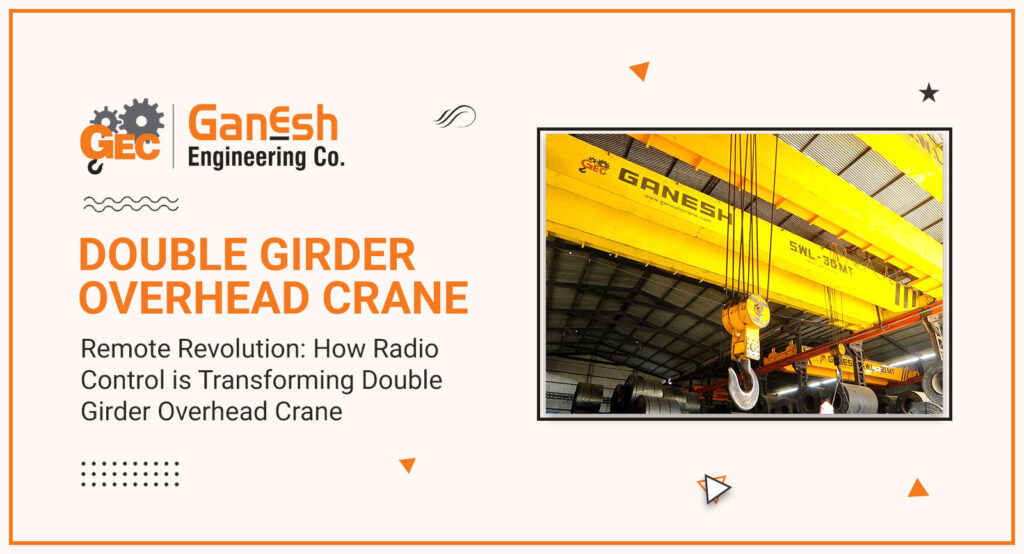
The world of material handling and heavy lifting is undergoing a remarkable transformation with advancements in technology. One of the notable developments in this domain is the integration of radio remote control systems in Double Girder Overhead Crane. This remote revolution is changing the way industries handle loads, enhancing safety, efficiency, and productivity. In this blog, we will explore the incredible journey of how radio control is transforming double overhead crane.
The Evolution of Double Girder Crane
Before delving into the role of radio control, it’s essential to understand the significance of double-girder cranes in industrial applications. These cranes are a staple in the manufacturing, construction, and logistics industries. They are designed to lift and transport heavy loads with precision and reliability.
Traditional Double Girder Overhead Crane were operated through pendant controls, requiring operators to be physically present near the crane to oversee its movements. While effective, this method had its limitations, especially in terms of operator safety and flexibility.
The Emergence of Radio Remote Control
The remote control revolution began with the introduction of radio technology to crane operations. Radio remote control systems for Double Girder Overhead Crane Suppliers in India allow operators to control the crane’s movements from a safe distance. This innovation has brought about several transformative benefits:
-
Enhanced Safety
Safety is paramount in any industrial setting, and the integration of radio remote control has significantly improved crane operations in this regard. Operators can now control the crane from a safe vantage point, reducing the risks associated with close proximity to heavy loads and moving machinery. This technology also provides emergency stop buttons on the remote, allowing instant cessation of operations in case of any unforeseen hazards.
-
Precision and Accuracy
Radio remote control systems offer precise control over the crane’s movements. Operators can maneuver loads with greater accuracy, minimizing the chances of accidents or damage to materials. This level of control is particularly valuable when handling fragile or valuable goods.
-
Increased Productivity
Efficiency and productivity are critical factors in the industrial world. Radio remote control accelerates operations by reducing the time required to position and handle loads. The intuitive interface of these systems allows operators to execute tasks swiftly and efficiently.
-
Flexibility and Adaptability
Radio remote control provides unmatched flexibility in crane operations. Operators can move around freely while controlling the crane, optimizing their vantage point for better visibility. This mobility ensures that they can adapt to changing situations and handle materials more effectively.
-
Operator Comfort
Traditional pendant controls could be physically demanding for operators who had to stand near the crane for extended periods. Radio remote controls offer ergonomic designs that prioritize operator comfort. This results in reduced operator fatigue and greater focus on the task at hand.
-
Reduced Downtime
The responsiveness of radio remote control systems minimizes downtime due to delays in load handling. Swift and precise operations translate into smoother workflows, ultimately leading to higher production output.
-
Compatibility and Integration
Radio remote control systems are designed to integrate seamlessly with existing double girder goliath crane. This means that industries can upgrade their equipment without the need for a complete overhaul, making the transition to radio control more cost-effective.
Challenges and Considerations
While the remote revolution brings a host of benefits, it’s essential to address some of the challenges and considerations associated with radio remote control systems:
-
Interference
Radio signals can be susceptible to interference, which may disrupt crane operations. Adequate measures must be in place to minimize interference risks.
-
Training:
Operators need thorough training to effectively use radio remote control systems, ensuring they understand the equipment’s capabilities and safety protocols.
-
Battery Life:
Depending on usage, the battery life of remote control devices may vary. Regular maintenance and charging are essential to prevent interruptions in operations.
Cost: While the benefits are significant, the initial cost of implementing radio remote control systems can be a consideration for some businesses. However, the long-term advantages often outweigh the initial investment.
Conclusion
The remote revolution driven by radio control technology is transforming the landscape of Double Girder Overhead Crane Manufacturers in India. From enhanced safety and precision to increased productivity and operator comfort, the benefits of radio remote control systems are substantial. These systems are not just a technological innovation; they are a testament to the industry’s commitment to improving efficiency and safety in material handling.
As industries continue to evolve, the adoption of radio remote control systems for double girder cranes is expected to grow. Embracing this technology is not merely a step forward; it’s a leap toward a safer, more efficient, and more productive future in heavy lifting and material handling. Ganesh Engineering Co. makes sure that they fulfill all the promises they make while manufacturing these double girder cranes for the industrial sector.

